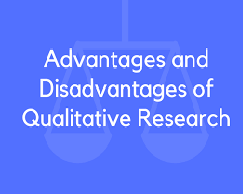The Pros and Cons of Qualitative Research Order Instructions: The pros and cons of qualitative research

The emphasis of this week’s discussion is on the importance of qualitative research and your ability to select the appropriate methodologies for the collection of the necessary data. It is important that you highlight the main issues involved in qualitative methodologies. Furthermore, you will try to tease out the strengths and weaknesses of different methods of data collection and sample selection.
The Pros and Cons of Qualitative Research Interpretivist Research
Aim: To identify and explore the human resource strategies that influence employee engagement within organizations in Qatar and to develop recommendations on how these human resource strategies can be changed in order to improve employee engagement.
The Pros and Cons of Qualitative Research Research Questions
RQ 1: Which human resource strategies influence employee engagement within organizations in Qatar?
RQ 2: How do these human resource strategies influence employee engagement within organizations in Qatar?
RQ 3: How can these human resource strategies be changed in order to improve employee engagement within organizations in Qatar?
End Product:Objective: To develop recommendations on how human resource strategies can be changed in order to improve employee engagement within organizations in Qatar.
The Pros and Cons of Qualitative Research Sample Answer
Qualitative research is a common expression about analytical methodologies and practices explained as an anthropological, ethnographic, field, naturalistic or the observer study, (Silverman, 2016). This type of the survey expresses stress on the significance of analyzing on variables in their original set up where they are found. Ample data is gathered by using open-ended questions that offer straightforward quotations. The researcher uses various methods such as grounded theory, case study, action research and ethnography to collect data, (Corbin, and Strauss, 2014). The methods of collecting data under the qualitative research methodologies have different pros and cons. The advantages and disadvantages of these methods will be discussed in general as follows, (Eriksson, and Kovalainen, 2015)
The Pros and Cons of Qualitative Research Advantages
- They help the researcher to get a clear vision on what to anticipate. That is they gather data in an authentic effort of corking data to bigger images.
- The collected data based on personal experiences and it is more powerful and compelling that the data gathered from the perspective of quantitative research.
- The data collected is gathered from few people or selected case. It means that the outcome and the findings cannot be stretched to the entire population.
The Pros and Cons of Qualitative Research Disadvantages
- The findings may take a lot of time. It makes it hard to present in illustration manner.
- The issues of anonymity and confidentiality can pose challenges throughout the presentation of the outcomes.
- Rigidity is more complicated to demonstrate, assess and maintain.
Furthermore, to come up with the probable outcome, the collected data should be sampled by using different sampling techniques depending on the methods used to obtain it. Some of these sampling methods include cluster snowball, purposive, and theoretical sampling. All of them has different merits and demerits.
Part two
Qatar University is one of the biggest universities in Qatar. To keep up with the Qatar Vision 2030, the University has formulated a human resource plan. The plan is aimed to assist with the accomplishment of the organizational strategic goals as explained by the Qatar University strategic plan and to become conscious of the objectives of the Qatar University reorganization project.
To ensure that the plan is amended to the latter, the Qatar University has to employee leadership and communication as part of their human resource so as to engage the employee, (Hackman, and Johnson, 2013). It’s because according to their vision for a human resource they state that “Human Resources supports Qatar University leadership in delivering educational excellence and in creating an employment experience that is recognized internally and externally as a model in the region – QU is both a model national university and a model employer!”.
Leadership and communication play a vital role in employee’s engagement. Leadership can be shaped as democratic and autocratic. In situations where there is a slighter adverse change, an authoritarian leader is needed to ensure that things get back to normal. The aim of QU is to make the University better. If there exist any non-performing staffs, then the autocratic leader must react. On the other hand, it is necessary for the voice of employees to be heard. Creating channels of communication will make the employees see they are important. With the Democratic leader, they can air their views since they know they will be heard.
Human resource management is inspected as a necessary activity in a company, (Grant, 2016). It assists in creating an aggressive edge for the firm by confidently engaging its employees. To make it happen, the ingredients that should be allowed are two-way communication and effective and efficient leadership. It builds an honest and open business environment where the workers feel that their views are heard, and the can contribute to decision making, (Men, 2014)
The Pros and Cons of Qualitative Research Bibliography
Corbin, J. and Strauss, A., 2014. Basics of qualitative research: Techniques and procedures for developing grounded theory. Sage publications.
Eriksson, P. and Kovalainen, A., 2015. Qualitative Methods in Business Research: A Practical Guide to Social Research. Sage.
Grant, R.M., 2016. Contemporary strategy analysis: Text and cases edition. John Wiley & Sons.
Hackman, M.Z. and Johnson, C.E., 2013. Leadership and Communication.
Men, L.R., 2014. Why leadership matters to internal communication: Linking transformational leadership, symmetrical communication, and employee outcomes. Journal of Public Relations Research, 26(3), pp.256-279.
Silverman, D. ed., 2016. Qualitative research. Sage.




